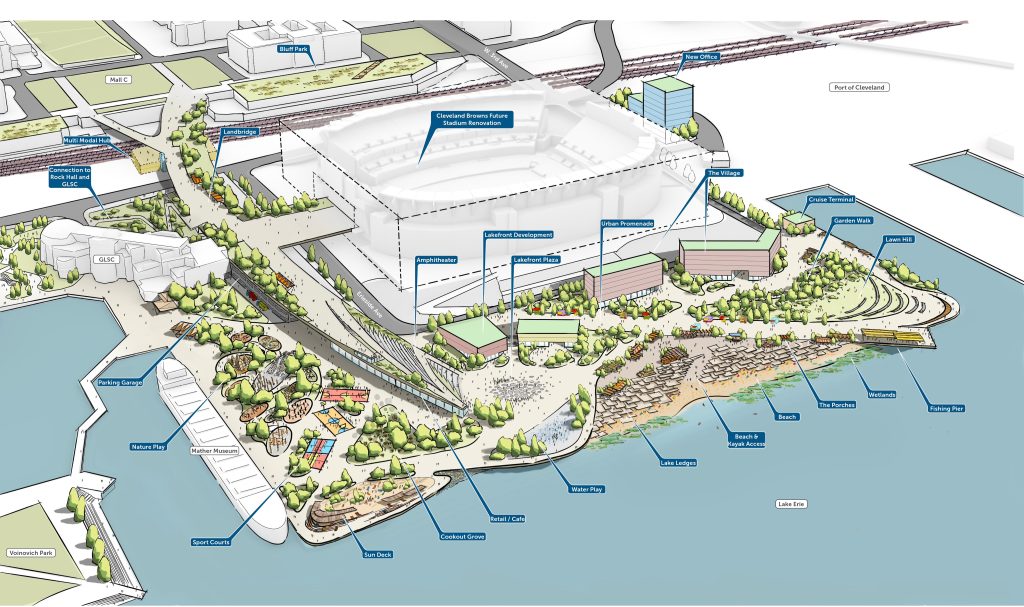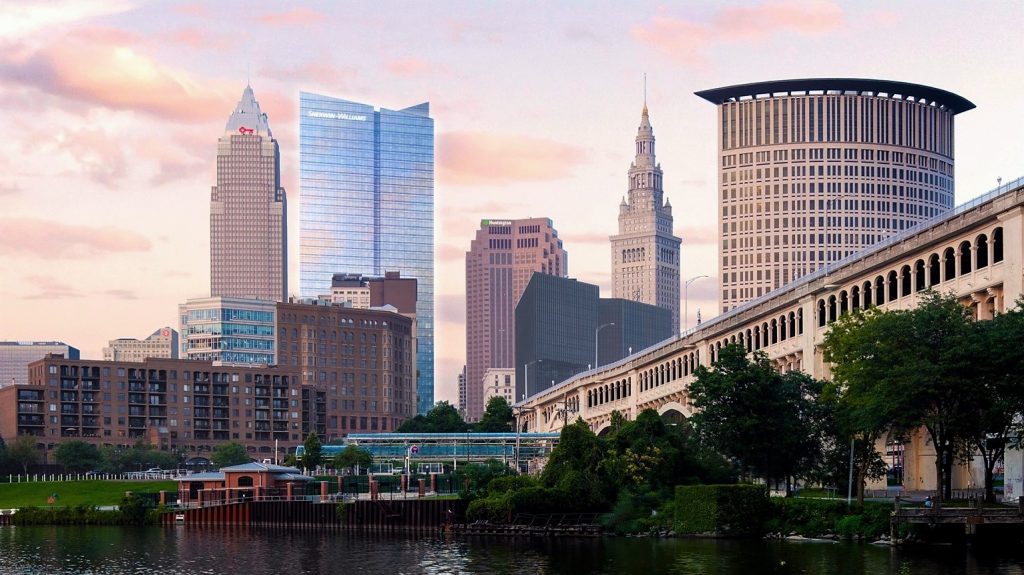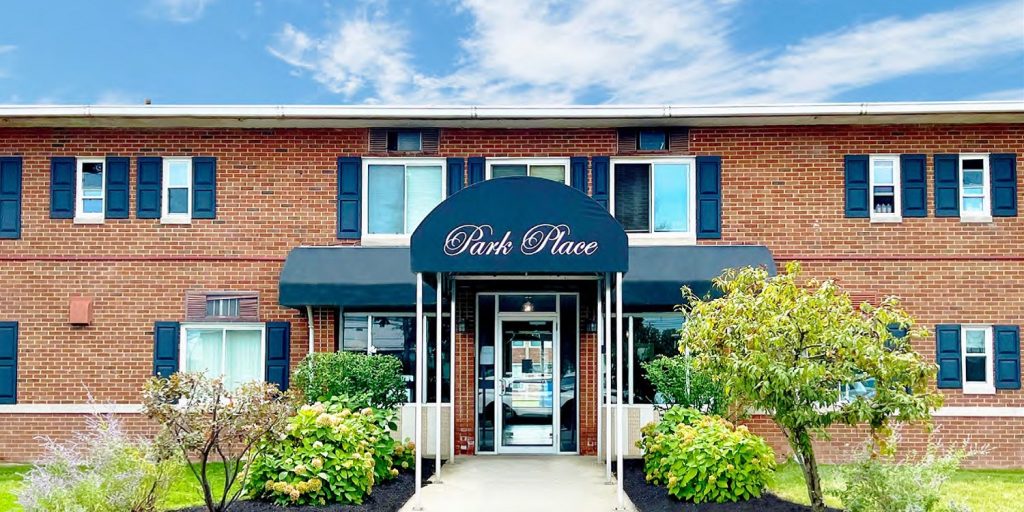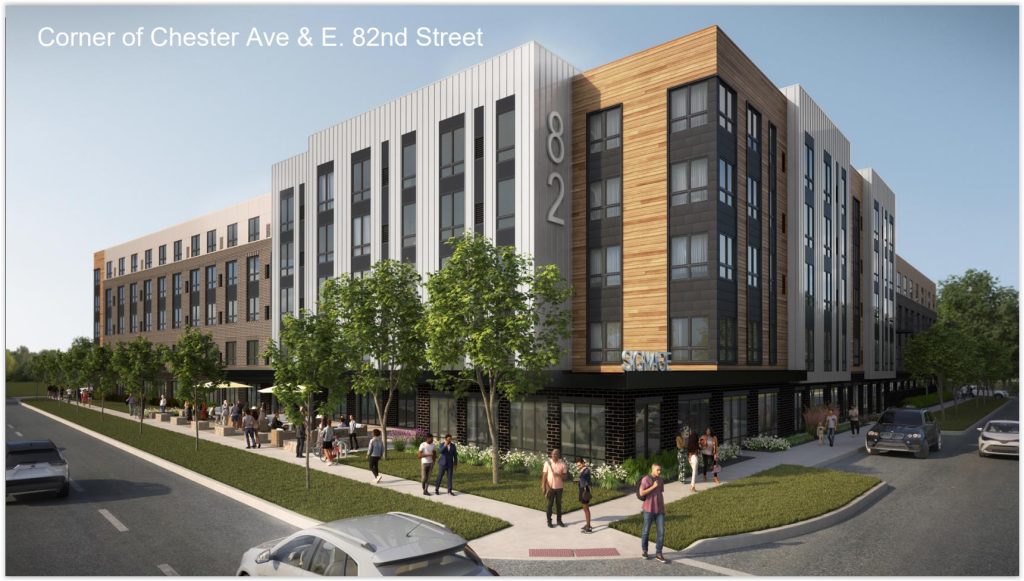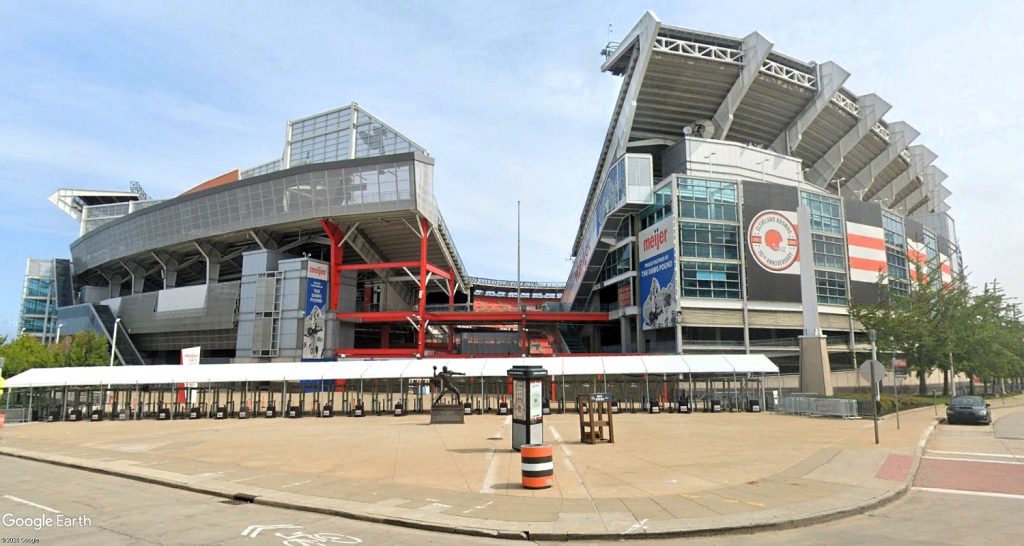
Are the days numbered for Cleveland Browns Stadium on Downtown Cleveland’s lakefront? They are if the public comes up with a way to fund half of the cost of a proposed $2.5 billion domed stadium in suburban Brook Park, as the Browns’ owners reportedly have requested (Google). CLICK IMAGES TO ENLARGE THEM.
Either site to also need infrastructure funding

ARTICLE UPDATED APRIL 30, 2024
When Cleveland Browns representatives last week showed state lawmakers designs for optional stadiums in Downtown Cleveland or in suburban Brook Park, they also shared something else — a proposed public-private cost sharing arrangement.
According to persons attending and familiar with the Browns-lawmakers meeting, they said the Browns estimated the new domed stadium in Brook Park might cost $2.5 billion while the renovated stadium downtown could cost half as much, or $1.2 billion. The football team is asking for public funding to pay half no matter where the stadium investment is made, the sources said.
And, for either site, the dollar amounts being tossed around are for the stadium only, they noted. While the presentations showed stadium-area developments like a hotel, shops and restaurants, the cost estimates didn’t include them because they might be entirely privately financed. The sources said the cost estimates also didn’t include changes to public infrastructure in and near either stadium option. Those would be almost entirely publicly funded.
Those could include big-ticket items such as enlarged sewers, relocated utilities, redesigned roadways and expanded public transportation. No price tag is available for those projects. At the end of the 2028 football season, which ends in winter 2029, the Browns’ lease with the city of Cleveland for the use of Cleveland Browns Stadium expires.
In addition to renovating the 1999-built stadium, the team has considered multiple sites in Cleveland and around Cuyahoga County while negotiating with Mayor Justin Bibb’s administration. NEOtrans broke the story in February that an affiliate of the Browns and their owners, the Haslam Sports Group, have a purchase agreement to acquire 176 acres at 18300 Snow Rd. in Brook Park — previously the site of two Ford Motor Co. plants.
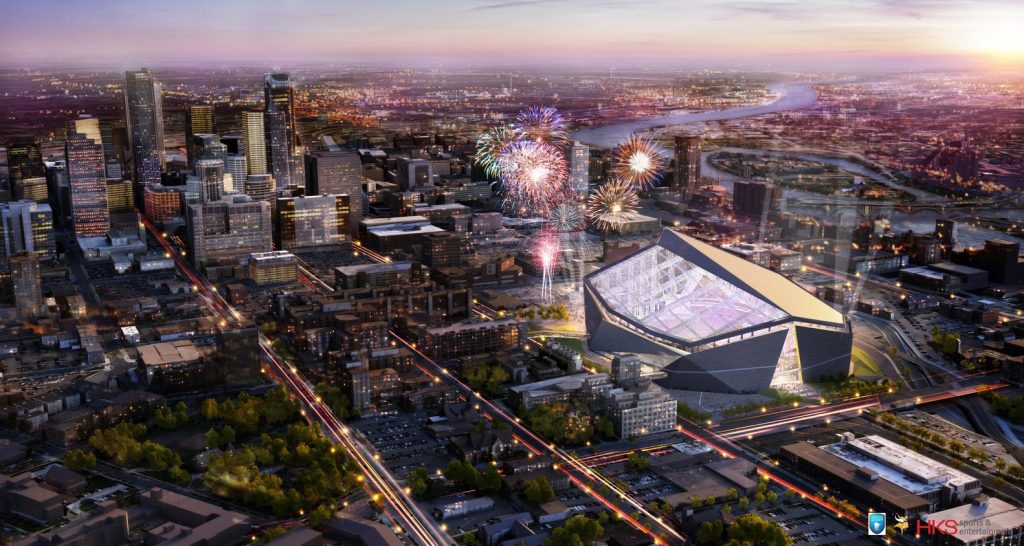
Minneapolis’ US Bank Stadium, home of the Minnesota Vikings, is reportedly one of the multi-purpose stadiums that inspired the Cleveland Browns to consider a domed stadium for Cleveland. But they sought it on an already vacant property in Cuyahoga County with good transportation access — leading them to Brook Park (HKS).
The April 22 meeting was held at the Vern Riffe Center in Columbus where many lawmakers’ offices are located. It was organized at the request of State Rep. Tom Patton (R-17, Strongsville) and a lobbying firm hired by the Cleveland Browns, the sources said.
When state lawmakers from around Ohio showed up at the meeting with the Browns’ representatives, all were urged to yield their cell phones before entering the meeting, the sources added. The Browns expressed concern about attendees taking pictures of the stadium renderings or otherwise recording the meeting.
The legislators were shown a video with renderings of both the renovated, open-air stadium in Downtown Cleveland and a proposed new domed stadium in Brook Park. Some lawmakers responded to the renderings matter-of-factly while others said that, if built, it would be the most attractive stadium in the National Football League. But they also had lots of questions including if the benefit to the public would be greater than the cost to the public.
“Anything we’re doing now is just part of our process of due diligence on stadium planning,” said Peter John-Baptiste, chief communications officer of the Cleveland Browns and their owners, the Haslam Sports Group, in a phone interview mail with NEOtrans. “It (April 22) was a positive meeting but it’s just another step. We’re still engaged in this process.”
He declined to address funding amounts, cost-sharing scenarios or refute the cost numbers reported earlier in this article. When asked when the public can see the stadium renderings, John-Baptiste answered simply, “Soon.”
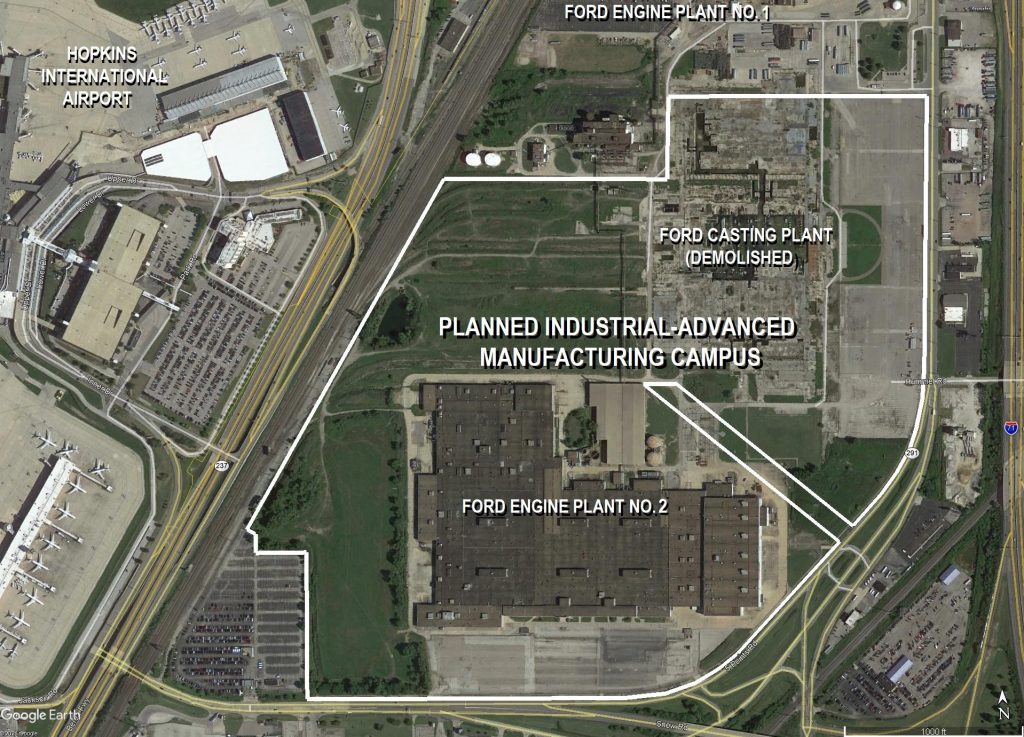
This is the 200-plus-acre Brook Park site four years ago before the second of two Ford plants was demolished and site preparations began for developing the Forward Innovation Center-West, an industrial campus. The diagonal right of way coming halfway into the site from Engle Road at lower right is a maintenance easement for First Energy-owned utilities that must be removed if a stadium is built here (Google).
He also did not wish to get into where the public funding would come from but considering the team’s request for a meeting last week with state lawmakers, a significant portion would come from the state.
Other possibilities are to value-capture tax revenues to be generated by the stadium and any ancillary developments. Those revenue could include income taxes, property taxes, admissions taxes, bed taxes and the like. Those could be earmarked by local, county and state governments to pay for infrastructure expenses, supportive developments or for the stadium itself.
“Nothing is finalized yet,” cautioned Rep. Bride Rose Sweeney (D-16, Westlake) when asked what last week’s presentation showed. She attended the first part of the meeting but had to leave due to a schedule conflict. “It gave me confidence that both (stadium) options are being thoroughly considered.”
She described the presentation as a high-level design video. As for the Brook Park portion which, at this time is the more enigmatic of the two options, the presentation showed a domed stadium but with a lowered height due to the nearby Hopkins International Airport. That would be accomplished by excavating the site. Adjacent to the stadium would be a new hotel, retail and restaurants. Sweeney said the infrastructure details are to be determined.
“Rep. Patton is unavailable for comment regarding this meeting, but you may be able to reach Rep. Sweeney for comment,” said Patton’s Legislative Aide Daniel Carmany.
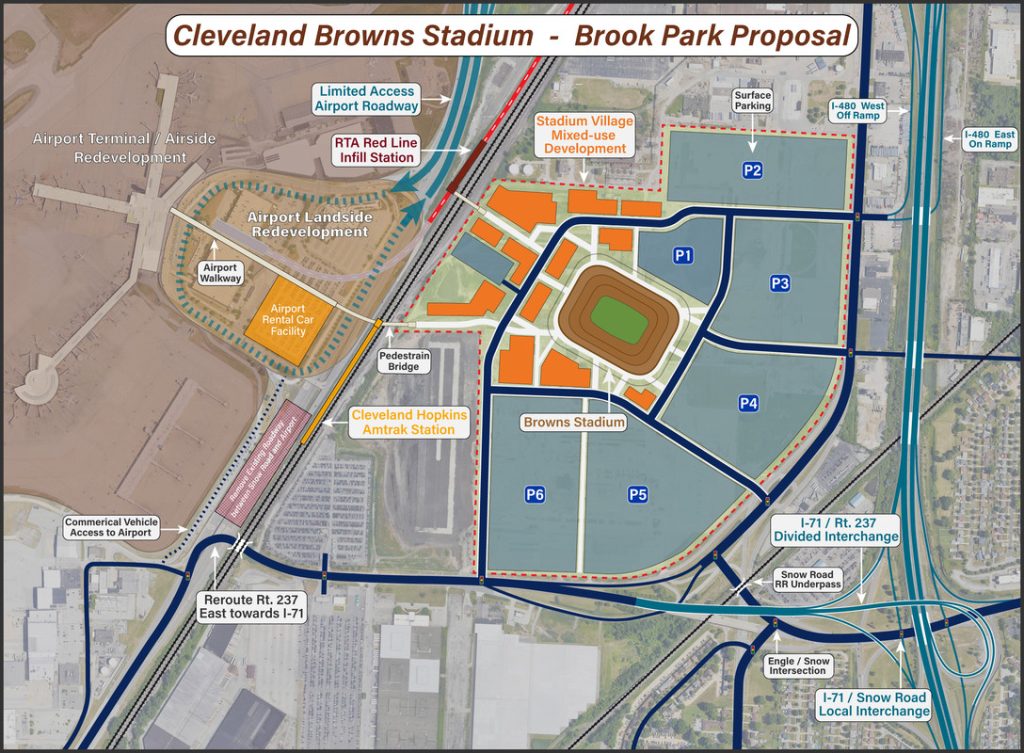
An unofficial rendering of what the Brook Park site could look like if developed with a stadium, hotel, retail, restaurants and lots of parking. This concept includes direct pedestrian links to Cleveland Hopkins International Airport and the Greater Cleveland Regional Transit Authority’s rapid rail Red Line either at the existing airport station and/or a new infill station outside the subway tunnel (Noah Belli).
One week before, Mayor Bibb also held a meeting with the Cuyahoga County delegation of state lawmakers. Bibb reportedly told the legislators that his administration and the Browns were still having “productive discussions” about a proposed $1.2 billion renovation of the existing, 67,431-seat Cleveland Browns Stadium.
Interestingly, Bibb apparently spent most of the meeting talking to legislators about the need for state funding for the proposed land bridge between downtown and the lakefront. The roughly $200 million land bridge would connect downtown’s grassy malls and a redeveloped waterfront via a wide, landscaped pedestrian and bike bridge over the Shoreway and railroad tracks owned and/or used by Norfolk Southern, CSX, Amtrak and the Greater Cleveland Regional Transit Authority.
“He (Bibb) talked about the land bridge about 90 percent of the time and gave us a basic rundown on the stadium (renovation),” said Rep. Mike Skindell (D-13, Lakewood). “He was kind of joking about it going to Brook Park while trying to convince us that renovating the existing stadium would be the wisest and cheapest move.”
Bibb spoke about Cleveland Browns Stadium even less in his State of the City speech March 28 at the Mimi Ohio Theatre in Playhouse Square. In that speech, which focused on a “bright future” for the city, he did not mention the stadium once although he did discuss lakefront development. But in separate communications, he has called keeping the Browns downtown a “priority.”
The two-year state capital budget passed by the Ohio House of Representatives in March has $20 million in its for the land bridge. The Senate is taking up the measure now. Skindell said the Ohio Senate may add another $20 million to the total. Last year, the House version of the state’s two-year operating budget had $62 million in it for the land bridge but the Senate removed it.
The city is also seeking a downgrade of the Shoreway through downtown to a pedestrian-friendly boulevard as part of its lakefront redevelopment plans. That and the land bridge are being sought regardless of happens with the stadium. City officials said those improvements would be needed even if the stadium is no longer there because a year-round use of the stadium’s 30-plus acres of land would be sought and need improved access from downtown.
Skindell was skeptical where roughly $1.25 billion would come from to pay the public’s share of a new domed stadium in Brook Park, as well as for any public infrastructure needed to support it.
“Brook Park can open up their wallets,” he joked. “Of course, they can’t. It’s a lot of money. It’s not just the stadium funding. You’re also talking about potential additional (freeway) interchange roadways, parking and sewers.”
One item not shown in the presentation was a direct pedestrian connector, such as moving walkway, from Hopkins International Airport to the new stadium site. Sources say the Browns have not considered the uniqueness of being able to walk from your airplane seat to your stadium seat without ever going outside. It would be the only National Football League stadium where such a connection is possible.
The distance from the middle of Hopkins’ ticketing lobby to the edge of the 176-acre property which the Haslams have under a purchase agreement is 2,000 feet, or one-third of a mile — about a 10-minute walk. From the ticketing lobby to the approximate geographic center of the potential stadium property is about a 3,700 feet or just over two-thirds of a mile, according to GoogleEarth.
END

